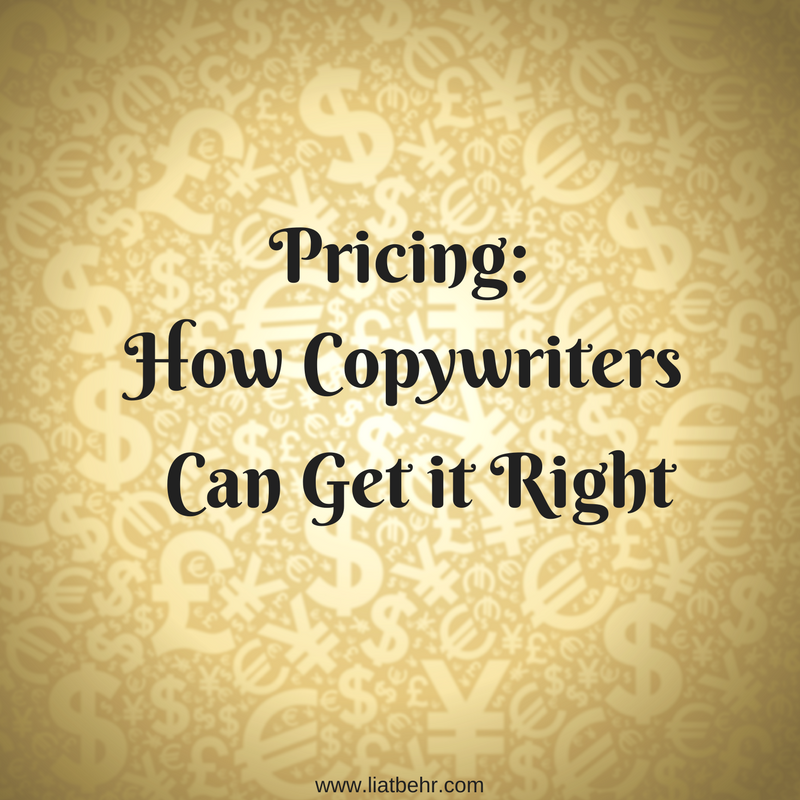Pricing is a tricky beast.
In the almost five years that I’ve been a freelance copywriter, I’ve learned a heck of a lot about pricing.
Mostly because I spent the first year getting it all wrong.
Over the past few weeks I’ve spoken to a few people about pricing. A couple of them asked me if I can put together a post about about the subject and it is to them that I dedicate this post.
This morning, I came across an excellent LinkedIn update about pricing which I’m going to elaborate on.
POSITION
Starting out as a freelance copywriter, I could only send specs (ads copywriters make up when they don’t yet have any real samples). Nobody knew my work. Nobody could refer work to me. I was on my own.
So when I first started out, more important than money was the understanding that I needed some amazing samples.
My first ever client, was a large and very well known organization in Israel. They paid me a pittance, but I could call them my client and they gave me more than a couple of very solid pieces I could use for my portfolio.
Their name and my work, began opening doors.
But that’s when I got a bit high on myself, thinking that I could charge whatever I want.
What I didn’t realize or yet understand, is that acceptance of pricing is based on trust.
And for trust you need more than just a few good samples. You need a relationship.
When you’ve truly gained the trust of a client, money will be no object. On the flip side, because your relationship with your client will be true and meaningful, you will also be fair both to your client and to yourself. And this is the sweet spot you’re looking for.
PRICE
Pricing requires a strategy.
When I first began copywriting, I put the value on my time, thinking that clients need to pay me for the time it takes me to work on something.
That turned out to be a horrible strategy for a couple of reasons.
- If you’re charging clients for your time, they can never know in advance how much the project will cost them. Unless working on retainer, I found that clients for the most part, hate this.
- If you’re charging by the hour, you might think that this is the only way to guarantee good pay. Nuh-uh. In fact, when you charge by the hour you will find that in the long run you are constantly being paid less as you get faster and better at your craft.
Instead charge per project. As you gain more and more experience with different types of projects, you will get faster and better. You will be able to command prices and get paid more per hour.
The caveat is that charging per project takes a ton of patience. You’re going to get pricing wrong, before you get it right.
PITCH
Understand your product and understand your value. This is vital.
In Pricing with Confidence, Reed Holden and Mark Burton pose what they term “the million dollar question.” I paraphrase: How can you set prices rationally if you don’t understand the value you’re providing for your customers?
This is one of the major keys to getting pricing right. Understanding your value and understanding your customers go hand in hand. The third piece of the puzzle, pricing, can be determined after you understand these.
But here’s the good news. It’s not actually that difficult to figure out where you provide value. Ask your clients; those same ones that adore you and your work. You’ll find that after you ask enough of your clients, messages begin to repeat themselves. The repeated messages – that’s where you’re making a difference. It’s where you’re providing value.
PROCESS
Aaron Orendorff said it best – “process is about the how.” Indeed. Process is another element that goes into determining pricing. What are you offering in your process.
Fast turnaround time? Unlimited revisions? Face-to-face meetings?
As you know, there are many elements that go into producing excellent copy. You have to be aware of your process and so does your client. If you provide only two revisions, it should be clear in your price proposal. A perfectly good working relationship can erode because of an unclear process. And it’s up to you and only you, the professional, to define what that process is.
PRUNE
There will be times when you find a client that’s totally up your alley. You love what they do, they love what you do, but there’s only one problem. They can’t afford you, or so they say. You may want to discount your price if it serves you. But it may not serve you. In such a case, let them go.
As Holden and Burton say, “unprofitable customers should be served by your competitors.”
Being too expensive is a good reason to let a potential client walk away.
But you’re really only in the position to let a client walk away when you have all the parts of the puzzle figured out – when you know who your ideal client is, when you understand your value and when you know that your pricing matches both.
Success tip
When I first started out, a good friend suggested that I create a spreadsheet to record work projects, the duration of the project (in hours and minutes) and cost per 250 words. After many projects, I found that my going rate (at the time) was or should have been, 375NIS (appox. $105) per 250 words. As you continue to record your projects, your pricing strategy will evolve and your pay will rise.
How will you adapt your pricing strategy?



